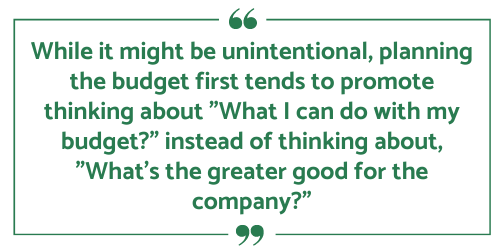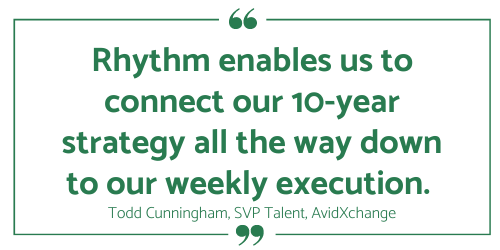Most companies do budgeting first and then strategy and annual planning. Think about this. If you have created a budget, you have inadvertently limited the freedom to think about what is possible. You are giving your team a financial view BEFORE you discuss what are the top priorities to focus on.
You need to ensure you have the funding to do the items planned for and that you are not funding something that has no alignment with your Annual Plan. Therefore, provide a directional budget that gives people the freedom to allocate money based on deep discussion and decisions on what are the top strategic and annual priorities.
Why should I create my annual plan before my budget?
Many companies begin their annual planning process by first creating their annual budget. Then they bring the budget to their annual planning session. This process has some inherent limitations:
- Some departments will feel compelled to spend their budget when they have been allocated more than they need.
- Conversely, some departments might not have enough funds to accomplish the company's goals.
- A common mistake is to allocate funds based on what got spent the previous year, not based on what each department actually needs.
- Teams may be thinking more about how to spend their budget instead of being focused on figuring out the most important things to accomplish.
This all promotes silo thinking. While it might be unintentional, planning the budget first tends to promote thinking about "What I can do with my budget?" instead of thinking about "What's the greater good for the company?"

Instead, there is a better way.
Make sure you have a strong facilitator that can drive the right discussions. At Rhythm Systems, we have been helping clients do this successfully for over 15 years. And make sure you not only decide on your top goals but have a strong action plan to execute on those goals.
What does great facilitation look like?
Most people think they are done once they are able to come up with the year’s main focus and top 3 to 5 things to do. But you are not done yet! A really good execution plan for the year should have clarity on the following items. Here is how our facilitators help our clients focus on the right things and fund them.
- We drive discussions to help you decide top 3 to 5 goals and then create an action plan to execute them.
Knowing the top 3 initiatives does not mean that you have a good execution plan. A good execution plan should have clear goals and milestones demonstrating how we as a team will achieve the annual plan. - We help lead the discussion to align resources to achieve the plan.
I often hear executives complain that they do not have enough resources to get it done, but their CEO expects them to “get it done anyway.” CEOs need to listen up. If your executives do not believe that they can get it done, piling on the pressure will not help get it done. The secret to success is having visibility in your execution plan. This visibility comes from having goals with very clear outcomes described and milestones with the right people owning these milestones to get it done. - Do you have the right people in place to accomplish this plan?
Do you need to hire and train new resources? Does your existing team need help and training to achieve their parts of the plan? - How will we align our budget to achieve the plan?
After figuring out the resources you need, you should now confirm the budget and investment to get this plan done.
Annual Planning is only Step 1. Without a strong execution process, you are in danger of missing your goals.
To confirm that you have a good and execution-ready plan, ask your team these questions to validate your plan for the year:
- Does this plan achieve our financial goals for the year?
- Does everyone know what they need to do?
- Do we have our team working on the top priorities?
- Are team members overloaded? Do they have time to work on their day jobs and the goals to drive company growth targets?
- Do we have strong accountability? Does every goal have an owner? And does every goal have clear outcomes defined?
A solid execution process and goal management software to manage all the details is critical.
Strategy and goal management software is critical. The cost for strategy management software is minimal compared to the cost of not meeting your annual goals. This type of software ensures that you have visibility into the plan and its progress and saves you from costly mistakes.
Don't wait until the end of the quarter to find out you didn't meet your goals.

The Rhythm platform helps you track your goals and ensures everyone is focused on the right work. It provides a bird's eye view of your long-term goals and a street-level view of your daily priorities simultaneously. It helps leaders create a culture where employees can ask for help and work together to fix issues.
And, best of all, it helps to eliminate the dreaded weekly meeting. Weekly meetings are where the work gets done. They are usually spent on status updates. Rhythm Software helps you spend 80% of the team's time on problem-solving.
If you'd like to learn more about Rhythm's strategy execution software from a Rhythm expert, click on the button below and schedule a one-on-one conversation.



